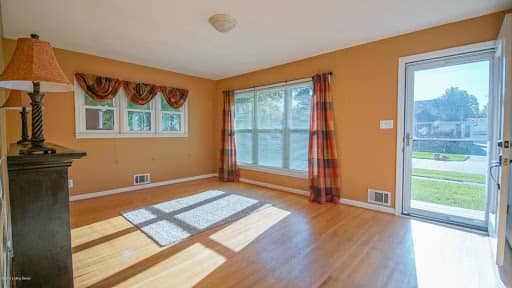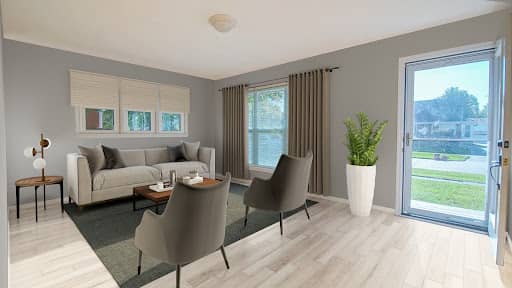Exploring the Debate: Virtual Staging vs Real Staging - Which One Reigns Supreme?
- Harmony Home Staging & Design

- Feb 21
- 4 min read
The real estate market is constantly evolving, especially in recent years with the rise of technology. This shift has transformed how homes are showcased, leading to two popular staging methods: virtual staging and real staging. Each option has its benefits and challenges that can affect a sale's outcomes. In this article, we will examine the advantages and disadvantages of both virtual and real staging to help you determine which approach suits your needs best.
What is Virtual Staging?
Virtual staging utilizes advanced digital tools to create lifelike images of furnished rooms utilizing the skills of a graphic designer. Real estate agents or homeowners can have the graphic designer digitally insert furniture, and decor, and even change wall colors without physically moving items. These high-quality images are then used across listings, marketing platforms, and open houses.
Pros of Virtual Staging
Cost-Effective: Virtual staging is significantly less expensive than real staging. For instance, traditional staging can cost around $1,000 to $5,000 for furniture rental and services, depending on the size of the home, quality and quantity of furniture, and the degree of staging. In contrast, virtual staging often costs between $200 to $600 for several images or per room, making it a budget-friendly option.
Flexibility: The ease of making changes in digital staging is remarkable. Want to swap a modern sofa for a classic one? It’s just a few clicks away. According to recent surveys, 76% of real estate professionals believe that showcasing different design styles can attract a wider range of potential buyers.
Quick Turnaround: Once photos are taken, virtual staging can be completed in days, a crucial advantage in fast-moving markets. For example, homes that are staged virtually can list within a week, allowing sellers to capitalize on immediate interest. The graphic designer doesn't even have to set foot in the house.
Cons of Virtual Staging
Potential for Misrepresentation: A significant concern is the risk of misleading potential buyers. If they visit the property expecting to see the staged images and find an empty or differently decorated space, their disappointment may hinder their interest.
Lack of Physical Presence: Virtual staging does not provide the tangible experience of real furniture and how to utilize unique spaces. Buyers often want to touch, feel, and experience a space, and the size of the furniture firsthand, which could lead them to overlook homes that are only virtually staged.
Potential for Legal Issues: When the proper precautions are NOT adhered to, real estate professionals can be sued for "false advertising". There can also be legal issues around copywriting infringement and the appropriate insurance needed for virtual staging.
What is Real Staging?
Real staging involves physically furnishing and decorating a home to enhance its appeal to potential buyers. This requires a professional home staging team to optimize the space thereby increasing its perceived value. Often includes decluttering and sometimes rearranging existing furniture.
Pros of Real Staging
True Representation: Real staging offers an accurate depiction of the home, allowing potential buyers to envision how they would utilize the space. A study performed by the National Association of Realtors (NAR) indicated that 81% of buyers can better visualize a property when it is staged.
Emotional Connection: Homes that are staged effectively create a warm and inviting atmosphere. This emotional resonance can be a powerful motivator, mentally helping buyers move in and feel that a home could be their next sanctuary.
Higher Selling Price: Research shows that staged homes can sell up to 20% more than unstaged homes. The appeal created by well-furnished spaces often leads to competitive offers, particularly in sought-after neighborhoods.
Cons of Real Staging
Higher Investment Cost: The financial investment of real staging can be considerable. Renting furniture and hiring professionals can contribute to investments that range from $1,000 to over $10,000, depending on the home's size, location, quality and quantity of furniture, the extent of staging, and the degree of staging required.
Time-Consuming: Real staging can delay the listing process. Coordinating schedules for the staging team and arranging furniture can take several days —time that could be critical in a vibrant real estate market.

Weighing Your Options
Both virtual staging and real staging have unique strengths and weaknesses.
Virtual staging is a more economical and adaptable choice, which is beneficial for sellers seeking a fast listing. However, can mislead buyers leading to longer sales times on the market.
Real staging offers an authentic experience that resonates more powerfully with buyers, encouraging them to mentally move into "their new home". However, the upfront investment should be considered and discussed with your professional stager to meet your timeframe and budget needs.
The decision boils down to individual situations, market conditions, and personal preferences. By taking into consideration the pros and cons discussed, sellers can make a more educated choice that aligns with their goals.
BELOW: Before and after pictures of virtual staging (slides R to L) Thanks to stuccco.com.







Comments